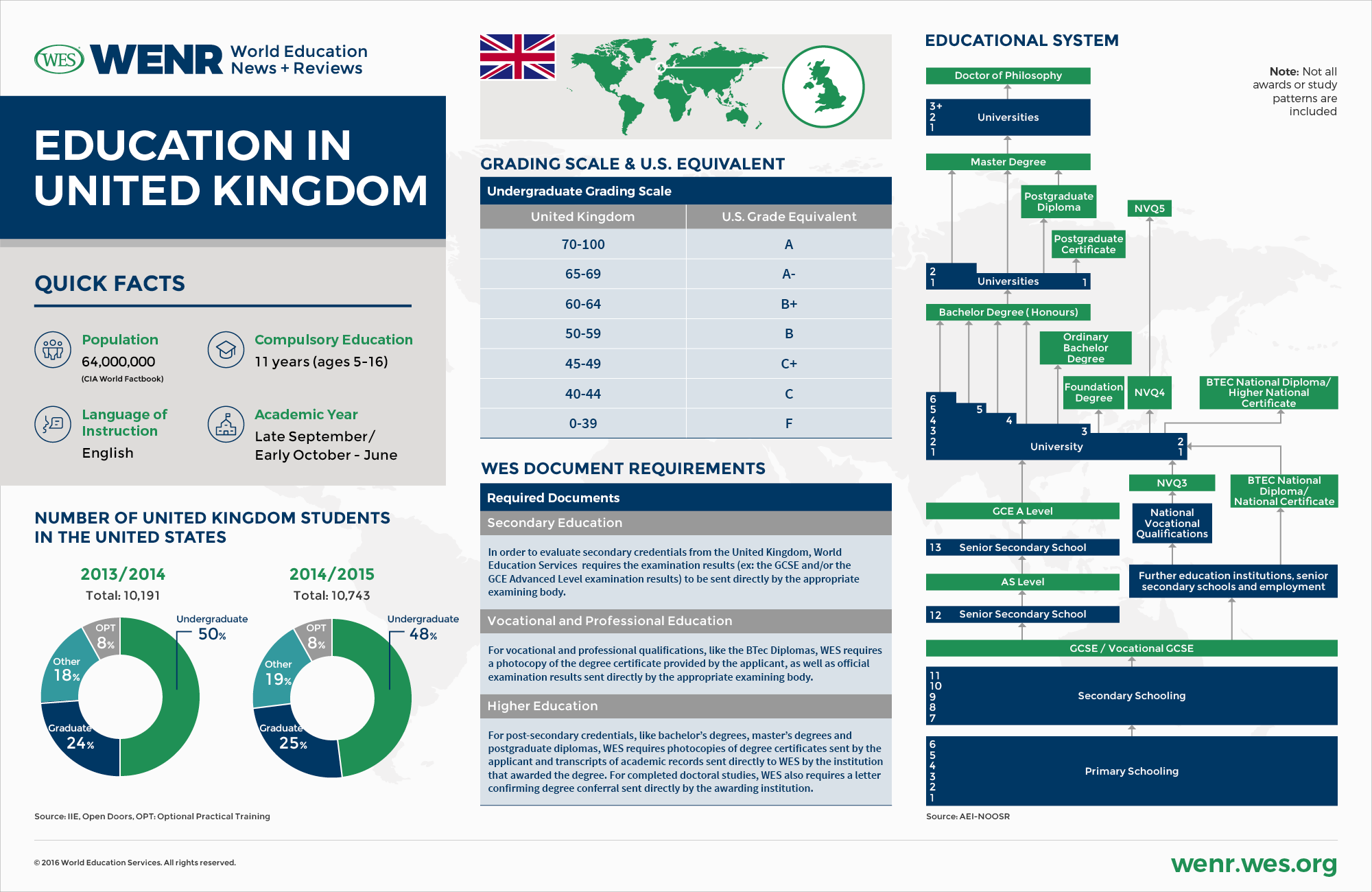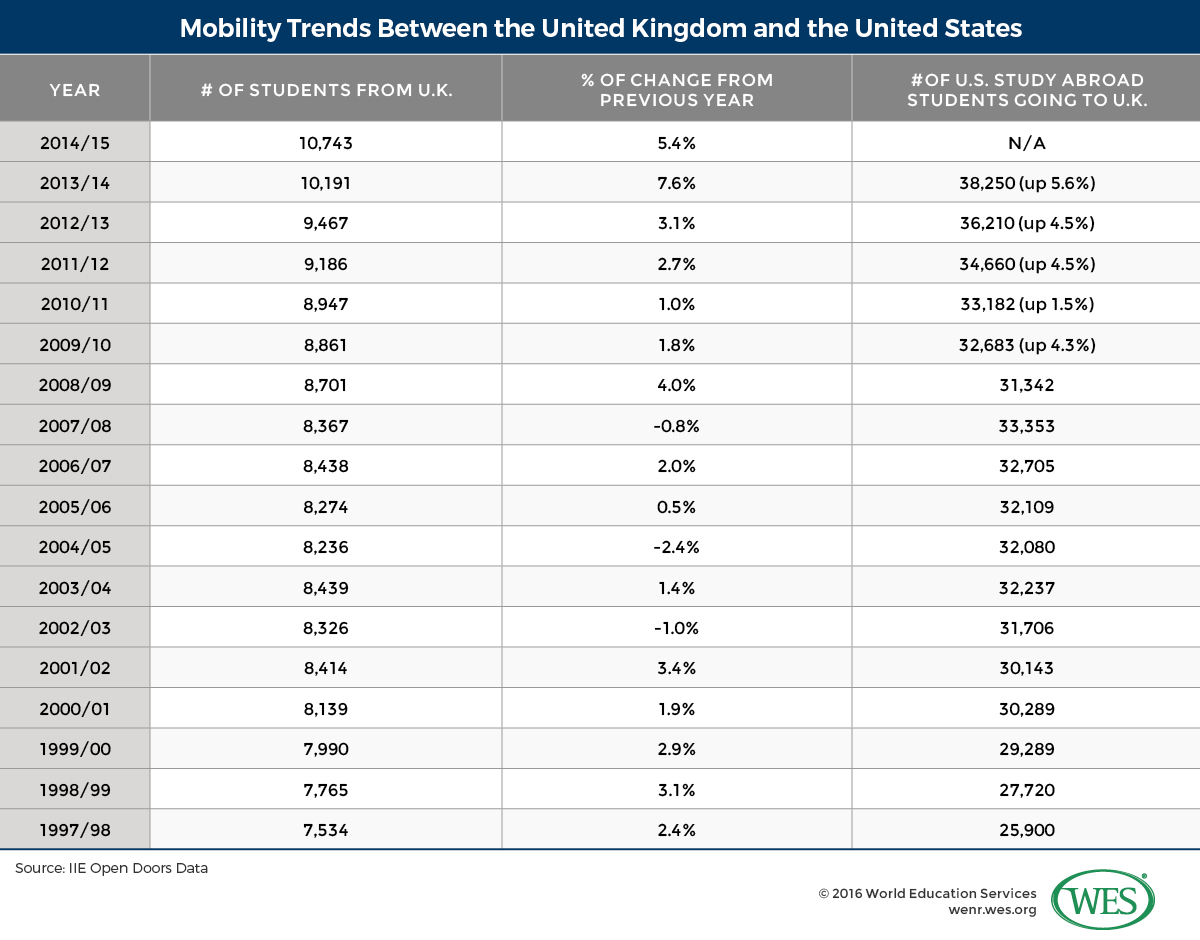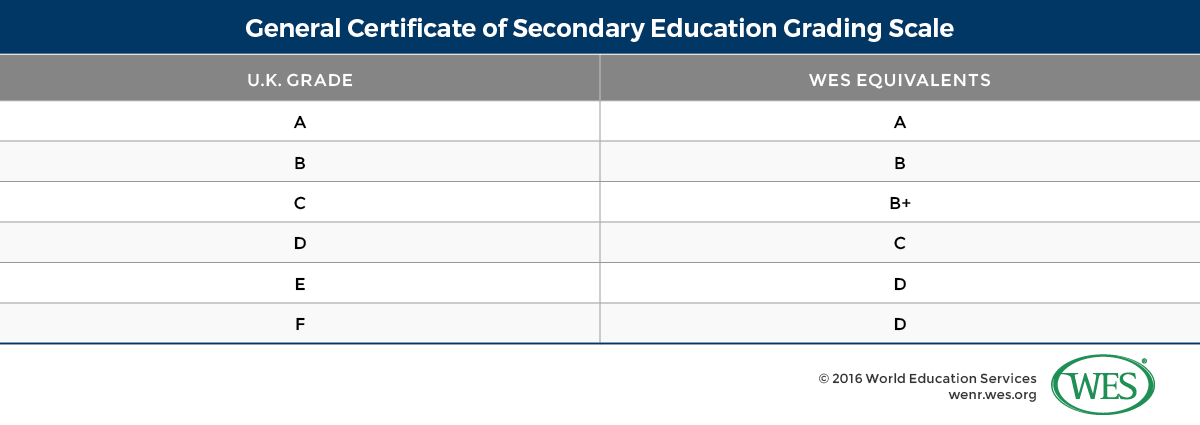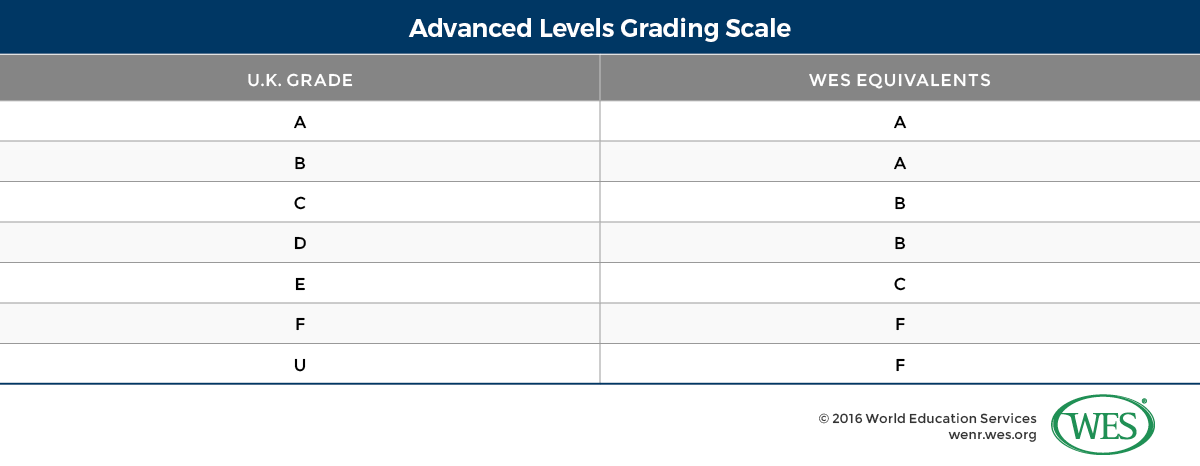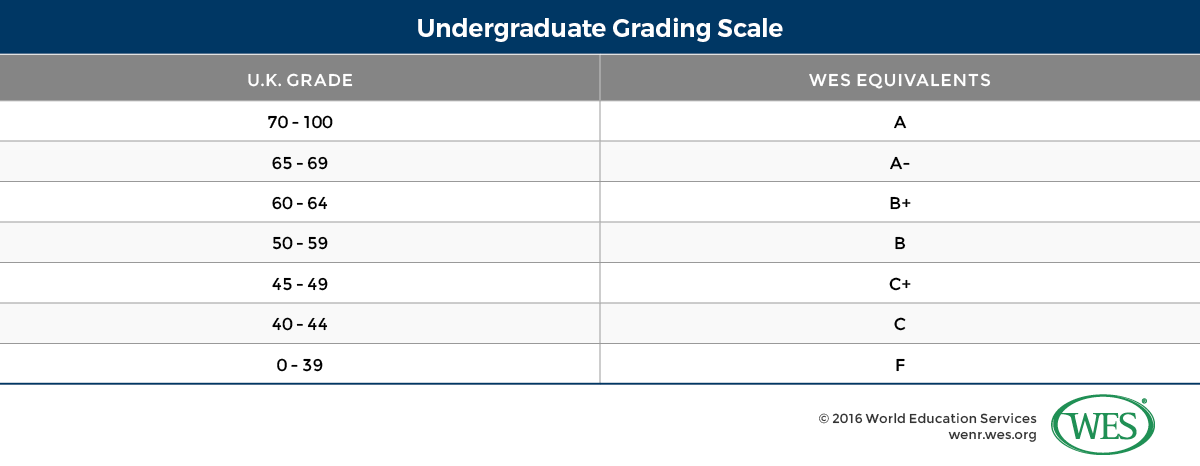Jessica Magaziner, Credential Analyst, WES
At its peak, British colonialism affected half the nations on the globe. As a result, the United Kingdom’s educational system emerged as one of the most influential models in the world: Even today, British credentials are awarded at more than 10,000 independent schools globally.
Higher education institutions (HEIs) in the U.K. are widely recognized for their research and teaching excellence and have traditionally been a magnet for international students. The U.K. likewise exports a high number of students. In the 2014-2015 academic school year, the nation was the 12th leading feeder of international students to US-based HEIs, contributing an estimated US$ 380 million to the nation’s economy.
This article seeks to provide admissions and enrollment professionals with a snapshot of the U.K’s education system from the primary through tertiary levels. It also offers an analysis of relevant mobility trends and an overview of the accreditation process for U.K. higher education institutions.
History
The U.K., with a population of over 64 million people, comprises [2] England, Wales, Scotland and Northern Ireland. Its history of higher education dates back to 1096, with the founding of the University of Oxford, popularly known [3] as “the oldest university in the English-speaking world.”
The 19th century saw dramatic expansion of higher education in the U.K., including the establishment of many medical and engineering institutions. In the decades after World War II, the British government sought to respond to the increased demand for higher education and technology training through two primary routes: The creation of new institutions, and an increase in the number of HEIs designated as universities. (This designation process is discussed in greater detail below.)
In 1992, the government awarded university status to additional colleges and polytechnic institutions, which, just like universities, provided bachelor’s, master’s and PhD degrees, albeit with a bent towards professional practice and application. Expansion was again initiated in the early 2000s, and has continued since.
Scotland, Wales and Northern Ireland have significant autonomy over education issues. Despite this independence, many aspects of the diverse U.K. educational systems remain similar. The most notable differences are seen in the Scottish education system; they are highlighted in this article as applicable.
International Student Mobility
Educational exchange between the United States and the United Kingdom has been significant for at least the past 18 years. The 2015 Open Doors Report on International Educational Exchange [4] indicates that the U.K. is the most popular choice as a destination for American students, attracting 12.5 percent [4] of all Americans participating in study abroad programs. The U.K. is likewise a significant contributor to U.S. institutions of higher education, stacking up as the “twelfth leading place of origin” for U.S.-bound students. The financial impact of these students is significant; in 2015, some 10,743 students from the U.K contributed US$ 380 million [4] to the U.S. economy.
The number of British students coming to the U.S. has trended upward since the late 1990s. The last decade saw some fluctuations, but the number of students coming to the U.S. has grown continually since the 2008-2009 academic year. In the 2014-2015 academic year, the numbers reached an all-time high.
British students in the U.S. typically study at the undergraduate level. In the 2014-2015 academic year, 48.5 percent [4]of the British students in the U.S. were studying at the undergraduate level and 24.5 percent [4] were enrolled in graduate studies. The remaining 27 percent [4] were participating in other types of programs, including Optional Practical Training (OPT.)
Education System
Education is compulsory for all children in the United Kingdom at the elementary and lower-secondary levels; most students are between the ages of five and 16. Instruction is offered in English, and the academic year runs from the end of September or the beginning of October to June. Most institutions operate on a trimester schedule, with three ten-week school terms.
As previously stated, the most significant differences within the education structures of the United Kingdom occur in the Scottish system. In an effort to highlight the specifics of each system, England, Wales, and Northern Ireland will be covered in one section, and Scotland will be addressed in a subsequent section.
Education in England, Wales, and Northern Ireland
Elementary and secondary education
Elementary education in England, Wales, and Northern Ireland is provided for six years to students between the ages of five and 11 [6].
Compulsory secondary education is offered for five years. Students are typically between the ages of 11 and 16 [6].
At 16, students may sit for multiple examinations in different subjects. Students sitting for the GCSE typically take between five and ten [6] examinations; they are free to choose the subjects and number. (The GCSE led to the creation of the International GCSE [7], which offers international students access to the British curriculum.) A General Certificate of Secondary Education [6] (GCSE) is awarded for each subject passed. Sitting for the exam exam marks the end of 11 years of compulsory education. World Education Services (WES) evaluates a minimum of three GCSE as equivalent to a high school diploma.
Students interested in higher education will typically pursue the pre-university or further education programs that are discussed in greater detail below. Other students may pursue vocational training.
Pre-university education
The GCSE can be followed by pre-university or further education. Pre-university education is a two-year senior secondary program that leads to a new round of examinations, the General Certificate of Education, Advanced Level (also known as GCE A-levels) [8]. As with the GCSE, students who sit for the exam choose the subjects and the number of examinations. (The average number taken is three.) WES awards undergraduate credit based on the nature and number of subjects passed.
The GCSE and the GCE, Advanced Level examinations are offered by regional examination boards, including Edexcel [9] Limited, the Assessment and Qualifications Alliance (AQA [10]) and the Oxford and Cambridge Examinations RSA [11] (OCR).
Vocational secondary education
Vocational programs [6] for studies in subjects like healthcare, information technology, business and engineering are also offered. After reform in 2007, these programs can now lead to one of several credentials, such as the Applied General Certificate of Education. This credential is less theoretical than the GCE A-level and is intended to help recipients to enter the workforce.
Further education
Further education is also known as senior secondary vocational education [9]. This refers to education that is no longer a part of the secondary system, but not included in higher education. It is focused on vocational programs, or hybrid general academic and vocational programs. The most common credential earned through further education is the BTEC Level 3 Diploma [6], which is awarded after two years of part-time study. WES evaluates the BTEC Level 3 as equivalent to a certificate-level program.
Admission to higher education
Admission to HEIs is managed by the Universities and Colleges Admissions Service [12] (UCAS). UCAS is responsible [6] for post-secondary admissions. Prospective students begin the UCAS application process [6] a year in advance of their anticipated enrollment. Once these prospective students are accepted by the admissions office, they are given a list of universities to which they may apply. HEIs then send conditional offers [6], or, in rare cases, unconditional offers to their chosen applicants. Conditional offers stipulate the examination results that must be obtained on the GCE A-Levels in order to guarantee admission. Most HEIs request [6] three GCE A-levels and three GCSE, though this depends on the institution and program.
For those students who wish to continue their studies after vocational secondary education, many British HEIs will admit [6] students on the basis of vocational A-level results or BTEC Level 3 Diplomas. This type of admission often requires [6] the student to continue in the same vocational field of study.
Higher Education
Higher education in the U.K. is categorized [6] as undergraduate or postgraduate study. Undergraduate study leads to a British “first degree [6],” which is generally a bachelor’s degree credential. Postgraduate programs [6] are entered into after a bachelor’s degree has been earned and result in master’s or doctorate degrees, or postgraduate diplomas.
Most bachelor’s degrees are earned after three years of undergraduate study, however there are many four-year programs as well. The programs result in degrees [13] such as the Bachelor of Arts, Bachelor of Science, Bachelor of Engineering, Bachelor of Laws, and Bachelor of Education, all of which are equivalent to a bachelor’s degree in the U.S. system.
Bachelor’s degrees can be awarded as “honors” [6] or “pass” [6] degrees. This indicates the type of program followed, the course load required to obtain the degree, and the final grade percentage earned. Both degrees usually require the same time to complete, but the honors program has a “higher study load and more examinations [6].” The level of achievement [6] of the student is designated by the class obtained. Students can achieve first class, upper second class, lower second class, or third class. Students typically need a bachelor’s degree with honors in the first or upper-second class in order to enter a master’s degree program.
Professional programs in areas like medicine, veterinary science, dentistry, and architecture typically last for five or six years of study. The Bachelor of Medicine and Bachelor of Surgery is equivalent to the first professional degree in medicine in the U.S., and enables the holder to practice as a medical doctor.
Master’s degree programs can be broken down into several types [6]. One type of master’s degree can be characterized by either a focus on coursework (master by instruction) or by a requirement for a final paper (master by research). These programs are typically one year in length and result in degrees [6] such as the Master of Arts or Master of Science and Business Administration. The other type of master’s degree is the Master of Philosophy (MPhil). This program is two years in length and is a research-focused degree.
Students typically enter into doctoral studies after earning a master’s degree, though it is possible to enter such programs with a bachelor’s degree and then complete additional classes. Doctoral programs are typically three years in length, which are comprised primarily of research leading to the completion of a dissertation. The credential earned is a Doctor of Philosophy (DPhil or PhD) and is the equivalent of a doctorate in the United States.
Education in Scotland
Elementary and secondary education
Elementary education in Scotland extends for seven years. Students are typically between the ages of five and 12.
Elementary education is followed by four years of lower-secondary education for students between the ages of 12 and 16 [6].
After 11 years [6] of compulsory elementary and secondary education, students sit for the Scottish Certificate of Education (SCE or SCE Standard Grade). The examination is offered at the standard or intermediate level [6]. The Scottish Qualifications Certificate (SQC,) awarded by the Scottish Qualifications Authority, was introduced in recent years to replace the SCE, Standard Grade. WES evaluates both the SCE and the SQC as the equivalent of a high school diploma.
Upper-secondary education
The SCE, Standard Grade is followed [6] by one to two year of specialized education, designed to prepare students for higher education, employment, or vocational training. This usually includes one to two additional years of study, and generally leads to credentials such as the SCE Higher Grade or SCE Advanced Higher Grade. Depending on the nature and number of subjects passed, WES offers undergraduate credit based on Higher and Advanced Higher examination results.
Vocational education
Vocational study in Scotland results in a Scottish Vocational Qualification (SVQ). SVQs are designed to give students the “the knowledge and skills required in order to do a specific job [15].” These credentials are taught at five different levels [16] of difficulty to address the training needs of all students, from novices to experienced professionals.
Admission to higher education
Admission to higher education in Scottish institutions is also managed by UCAS. Most Scottish institutions require four or five SCE Higher [6] credentials as an entrance requirement.
Higher education
The higher education system in Scotland is very similar to the system in place in England, Wales, and Northern Ireland. One distinction [6] is that bachelor’s degree with “honors,” which traditionally takes four years to complete; “pass” degrees are earned after three years of study.
Another difference is the “first degree [6],” which is awarded by the four oldest universities in Scotland. The University of Aberdeen, the University of St. Andrews, the University of Edinburgh and the University of Glasgow all award a Master of Arts (Honors) [6] degree after four years of study; this credential is viewed by World Education Services as equivalent to a bachelor’s degree.
Institutions
Higher education throughout the U.K. is offered at a variety of institutions [6], including universities, institutes, colleges, and schools. Higher education institutions can offer both professional and academic programs, regardless of the institution’s title. Universities, and some other HEIs, have the autonomy [17] to establish their own curricula and program requirements, and to award recognized degrees.
Other institutions, without the right to award these degrees, are able to offer post-secondary programs and have degrees validated by a recognized university.
Credit Systems
British institutions typically use the Credit Accumulation and Transfer Scheme [18](CATS) for calculating academic course loads. This is a point-based system that allocates [19] 120 points per year for a full-time course load that fulfills the program requirements, yielding [6] 360 points for a three-year bachelor’s degree or 480 points for a four-year bachelor’s degree. In order to aid student mobility throughout Europe, institutions have also begun utilizing the European Credit Transfer System (ECTS). The standard conversion rate between these credit systems is 1 ECTS = 2 CATS. The ECTS allocates 60 credits per year for a full-time course load, or 180 credits for a three-year bachelor’s degree and 240 credits for four-year bachelor’s degree.
Grading Scales
Secondary Education
Higher Education
Accreditation in England, Wales, and Northern Ireland
The U.K. does not have a statewide accreditation process [6]. The existing accrediting agencies do not have any governmental authority [6], and are therefore focused on private institutions and professional study programs.
Higher education institutions are recognized by the British government through legislation, such as a Royal Charter or an Act of Parliament, and are referred to as “recognised bodies [6].” Only these institutions are authorized [24] to award degrees in the U.K.
The designation “listed bodies [25]” refers to institutions that have not been recognized through legislation, but that are allowed to offer a program specifically designed to lead to a degree awarded by a “recognised body.”
Other institutions have governmental authorization to “award their own unique degrees” and are able to deliver diplomas referred to as “recognised awards [26].” These institutions are monitored by the authority of the Department for Business Innovation and Skills [27].
Accreditation in Scotland
The accreditation of HEIs in Scotland falls under the authority [28] of the Department for Innovation, Universities and Skills and the Quality Assurance Agency. As in the rest of the U.K., Scottish institutions have to be deemed “recognised bodies” by the British government in order to award degrees. Excluding university degrees, the Scottish Qualifications Authority (SQA) is responsible for the national accreditation of all recognized qualifications [29] such as the SQC.
Document Requirements
Secondary Education
In order to evaluate secondary credentials from the United Kingdom, World Education Services requires the examination results (ex: the GCSE and/or the GCE Advanced Level examination results) to be sent directly by the appropriate examining body.
Vocational and Professional Education
For vocational and professional qualifications, like BTEC Diplomas, WES requires a photocopy of the degree certificate provided by the applicant, as well as official examination results sent directly by the appropriate examining body.
Higher Education
For post-secondary credentials, like bachelor’s and master’s degrees, WES requires transcripts of academic records sent directly to WES by the institution that awarded the degree and photocopies of degree certificates sent by the applicant. For completed doctoral studies, WES also requires a letter confirming degree conferral sent directly by the awarding institution.
All information on WES required documents can be found here [30].
 [31]Sample Documents: The U.K.
[31]Sample Documents: The U.K.
This file [31] of Sample Documents (pdf) shows the following set of annotated credentials from the U.K. education system:
- High school examination results issued by the University of Cambridge International Examinations (General Certificate of Education, Ordinary Level
- High school examination results issued by Edexcel Limited (International General Certificate of Secondary Education – IGCSE)
- Degree certificate for a three-year bachelor’s degree in nursing from the University of Sunderland (Bachelor of Science Honours)
- Academic transcripts for a three-year bachelor’s degree in economics from the University College of London (Bachelor of Science Honours)
- Academic transcripts for a five-year degree in civil engineering from the University of Glasgow (Master of Engineering Honours)
- Degree certificate and academic transcripts for a one-year master’s degree in forensic psychology from the University of Leicester

